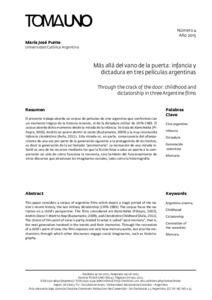Por favor, use este identificador para citar o enlazar este ítem:
https://repositorio.uca.edu.ar/handle/123456789/15079| Título: | Más allá del vano de la puerta : infancia y dictadura en tres películas argentinas Through the crack of the door : childhood and dictatorship in three Argentine films |
Autor: | Punte, María José | Palabras clave: | CINE ARGENTINO; DICTADURA MILITAR; MEMORIA; HISTORIOGRAFIA; INFANCIA | Fecha de publicación: | 2015 | Editorial: | Universidad Nacional de Córdoba. Facultad de Artes. Departamento de Cine y Televisión | Cita: | Punte, M. J. Más allá del vano de la puerta : infancia y dictadura en tres películas argentinas [en línea]. Toma Uno. 2015, 4. Disponible en: https://repositorio.uca.edu.ar/handle/123456789/15079 | Resumen: | Resumen: El presente trabajo aborda un corpus de películas de cine argentino que confrontan con
un momento trágico de la historia reciente, el de la dictadura militar de 1976‐1983. El
corpus aborda dicho momento desde la mirada de la infancia. Se trata de Kamchatka (Piñeyro,
2002), Andrés no quiere dormir la siesta (Bustamante, 2009) y la muy reconocida
Infancia clandestina (Ávila, 2011). Esta mirada es, en parte, consecuencia del afianzamiento
de una voz por parte de la generación siguiente a la protagonista de los hechos,
es decir la generación de la así llamada “posmemoria”. La recreación de una mirada infantil
es uno de los recursos mediante los que la ficción lleva a cabo un aporte a la comprensión
no sólo de cómo funciona la memoria, sino también del funcionamiento de
otros discursos que atraviesan los imaginarios sociales, tales como la historiografía. Abstract: This paper considers a corpus of argentine films which depict a tragic period of the nation's recent history, the last military dictatorship (1976‐1983). The corpus focus the narrative on a child's perspective. The films considered are Kamchatka (Piñeyro, 2002), Andrés Doesn´t Want to Nap (Bustamante, 2009), and Clandestine Childhood (Ávila, 2011). The choice of this point of view is partly related to what is called “post‐memory”, that is, the next generation involved in the events and their memories. Through the recreation of a child´s point of view, the films exposes not only how memory works, but also the mechanisms through which other discourses engage social imaginaries, such as historiography. |
Cobertura Espacial: | Argentina | Cobertura Temporal: | SIGLO XX | URI: | https://repositorio.uca.edu.ar/handle/123456789/15079 | ISSN: | 2312-9692 (impreso) 2250-4524 (en línea) |
Disciplina: | LITERATURA | Derechos: | Acceso abierto | Fuente: | Toma Uno. 2015, 4 |
| Aparece en las colecciones: | Artículos |
Ficheros en este ítem:
| Fichero | Descripción | Tamaño | Formato | |
|---|---|---|---|---|
| más-allá-vano-puerta.pdf | 215,34 kB | Adobe PDF |  Visualizar/Abrir |
Visualizaciones de página(s)
74
comprobado en 27-abr-2024
Descarga(s)
202
comprobado en 27-abr-2024
Google ScholarTM
Ver en Google Scholar
Este ítem está sujeto a una Licencia Creative Commons

